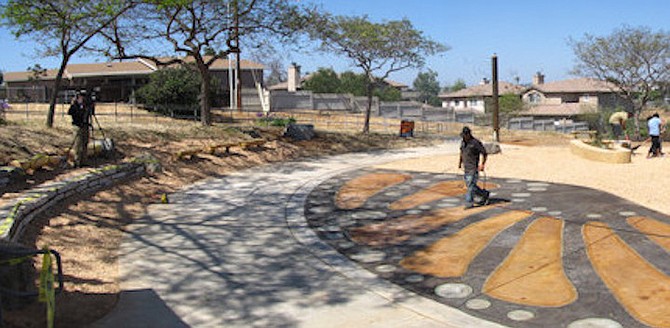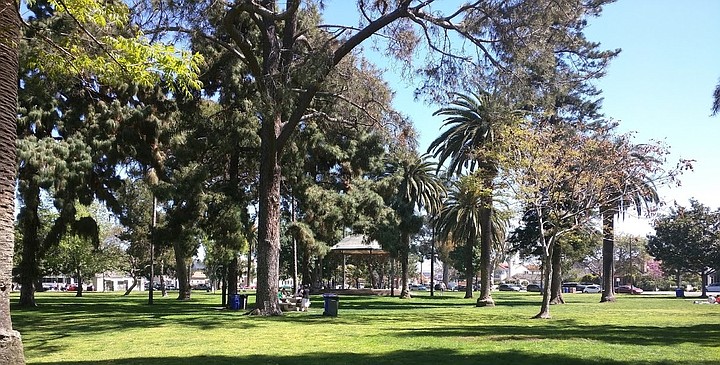 Facebook
Facebook
 X
X
 Instagram
Instagram
 TikTok
TikTok
 Youtube
Youtube

San Diego beat its 2020 goal for slashing greenhouse gases by two years. But tucked in its climate action plan is one key strategy that barely budged. Boosting the tree canopy by 15 percent. Not even close.
The sluggish growth of the urban forest may have to do with the newness of trees as climate solution. Not all cities include them in their climate action plan, where goals can be set and progress measured. According to the nonprofit Tree San Diego, the region's canopy is 60-70 percent below what it should be for a healthy environment.

But as communities strive to meet state and local climate goals, trees are putting down roots.
Coronado recently included trees in its budding climate action plan, expected to be completed in early 2021. The tree initiative isn't all about shading and beautifying islands of cement and car-choked streets; those are bonuses. The real goal is removing carbon from the air.
As trees grow, they absorb carbon dioxide emissions through photosynthesis, storing the carbon in leaves, branches, bark and roots. Studies show it can be an effective way to trap greenhouse gases.
Announcing the proposal, Coronado Mayor Bailey and Councilmember Benzian called for "an initial goal of planting 1,001 new trees by the end of 2024 and the eventual goal of planting enough new trees to sequester all carbon emissions from car trips" by residents that begin and end within city limits by 2030.
The city still needs to find out which trees are best at sequestering carbon, said Coronado city manager Blair King. The first milestone in their climate plan will be completion of a greenhouse gas inventory in March, followed by public suggestions, then setting greenhouse gas reduction targets and measures.
Where trees flourish, so do the benefits, advocates say. In Balboa Park, 15,350 trees hold 7,000 metric tons of carbon storage. Or, in dollar-terms, $70,000 in pollution removed; $14,000 in stormwater filtered; and $32,000 of carbon dioxide trapped, according to the San Diego Regional Urban Forests Council.
Another environmental group keeps tabs on how well cities are putting trees to work. In February, the Climate Action Campaign released its 2018 report card, evaluating climate plans around the county - including the use of trees. While strong on other carb-cutting methods, San Diego "has not made any notable progress towards the urban tree canopy target," the report said, citing insufficient staff resources.
No city was fully on track to meet their goals. Like Coronado, several cities have a plan "in progress" or are updating their plans. National City's climate plan, in place since 2011, was found to have "significant room for improvement," and is without a tree canopy goal.
In November, National City amended its outdated urban forest management plan and tree preservation ordinance; a requirement of a Cal Fire urban forestry grant the city applied for.
An inventory counted 9,397 city-managed trees, comprised of 8,013 parkway trees, 1,125 park trees and 259 median trees. (The grant will add 1,700 more).
In a survey about the trees' benefits, residents, who are surrounded by highways, said air quality is number one. "These trees are delivering that service," consultant Michael Huff told the city council.
The city's trees store about 3,543 pounds of air pollutants every year, he said. The amount of carbon they capture "is equivalent to 1,285 vehicles being driven 11,000 miles per year, or carbon emission related to charging seven million cell phones."
It's a young, fairly healthy forest, and its 191 individual species "is on par with some rain forests," Huff said. The rich diversity is insurance against loss by pests and pathogens.
The city allocates about $224,000 annually for tree maintenance, $23.80 per tree, "which is pretty good." They do a great job managing their trees, on a budget lower than average in southern California, he said. The park department's 2.5 year trim cycle is "outstanding." Five to seven years is probably average, he said, "and there are cities, I won't name them, that are 20-plus years."
Vice mayor Morrison explained a certain tree canopy mystery in National City. In the 90s, the city got a grant for 5,000 trees, which all went in west of the 805, leaving the other side untouched. "That's why we have a whole lot more trees in the public right of ways west of the 805 than you do east of the 805."
The tree-rich side had its own challenges. One area near Butterfly Park "got planted three different times and they immediately died out." Finally, soil testing determined that people had been parking and changing their oil there for decades, then dumping the old oil on the ground.
"So of course it kept anything from growing."


San Diego beat its 2020 goal for slashing greenhouse gases by two years. But tucked in its climate action plan is one key strategy that barely budged. Boosting the tree canopy by 15 percent. Not even close.
The sluggish growth of the urban forest may have to do with the newness of trees as climate solution. Not all cities include them in their climate action plan, where goals can be set and progress measured. According to the nonprofit Tree San Diego, the region's canopy is 60-70 percent below what it should be for a healthy environment.

But as communities strive to meet state and local climate goals, trees are putting down roots.
Coronado recently included trees in its budding climate action plan, expected to be completed in early 2021. The tree initiative isn't all about shading and beautifying islands of cement and car-choked streets; those are bonuses. The real goal is removing carbon from the air.
As trees grow, they absorb carbon dioxide emissions through photosynthesis, storing the carbon in leaves, branches, bark and roots. Studies show it can be an effective way to trap greenhouse gases.
Announcing the proposal, Coronado Mayor Bailey and Councilmember Benzian called for "an initial goal of planting 1,001 new trees by the end of 2024 and the eventual goal of planting enough new trees to sequester all carbon emissions from car trips" by residents that begin and end within city limits by 2030.
The city still needs to find out which trees are best at sequestering carbon, said Coronado city manager Blair King. The first milestone in their climate plan will be completion of a greenhouse gas inventory in March, followed by public suggestions, then setting greenhouse gas reduction targets and measures.
Where trees flourish, so do the benefits, advocates say. In Balboa Park, 15,350 trees hold 7,000 metric tons of carbon storage. Or, in dollar-terms, $70,000 in pollution removed; $14,000 in stormwater filtered; and $32,000 of carbon dioxide trapped, according to the San Diego Regional Urban Forests Council.
Another environmental group keeps tabs on how well cities are putting trees to work. In February, the Climate Action Campaign released its 2018 report card, evaluating climate plans around the county - including the use of trees. While strong on other carb-cutting methods, San Diego "has not made any notable progress towards the urban tree canopy target," the report said, citing insufficient staff resources.
No city was fully on track to meet their goals. Like Coronado, several cities have a plan "in progress" or are updating their plans. National City's climate plan, in place since 2011, was found to have "significant room for improvement," and is without a tree canopy goal.
In November, National City amended its outdated urban forest management plan and tree preservation ordinance; a requirement of a Cal Fire urban forestry grant the city applied for.
An inventory counted 9,397 city-managed trees, comprised of 8,013 parkway trees, 1,125 park trees and 259 median trees. (The grant will add 1,700 more).
In a survey about the trees' benefits, residents, who are surrounded by highways, said air quality is number one. "These trees are delivering that service," consultant Michael Huff told the city council.
The city's trees store about 3,543 pounds of air pollutants every year, he said. The amount of carbon they capture "is equivalent to 1,285 vehicles being driven 11,000 miles per year, or carbon emission related to charging seven million cell phones."
It's a young, fairly healthy forest, and its 191 individual species "is on par with some rain forests," Huff said. The rich diversity is insurance against loss by pests and pathogens.
The city allocates about $224,000 annually for tree maintenance, $23.80 per tree, "which is pretty good." They do a great job managing their trees, on a budget lower than average in southern California, he said. The park department's 2.5 year trim cycle is "outstanding." Five to seven years is probably average, he said, "and there are cities, I won't name them, that are 20-plus years."
Vice mayor Morrison explained a certain tree canopy mystery in National City. In the 90s, the city got a grant for 5,000 trees, which all went in west of the 805, leaving the other side untouched. "That's why we have a whole lot more trees in the public right of ways west of the 805 than you do east of the 805."
The tree-rich side had its own challenges. One area near Butterfly Park "got planted three different times and they immediately died out." Finally, soil testing determined that people had been parking and changing their oil there for decades, then dumping the old oil on the ground.
"So of course it kept anything from growing."
Comments